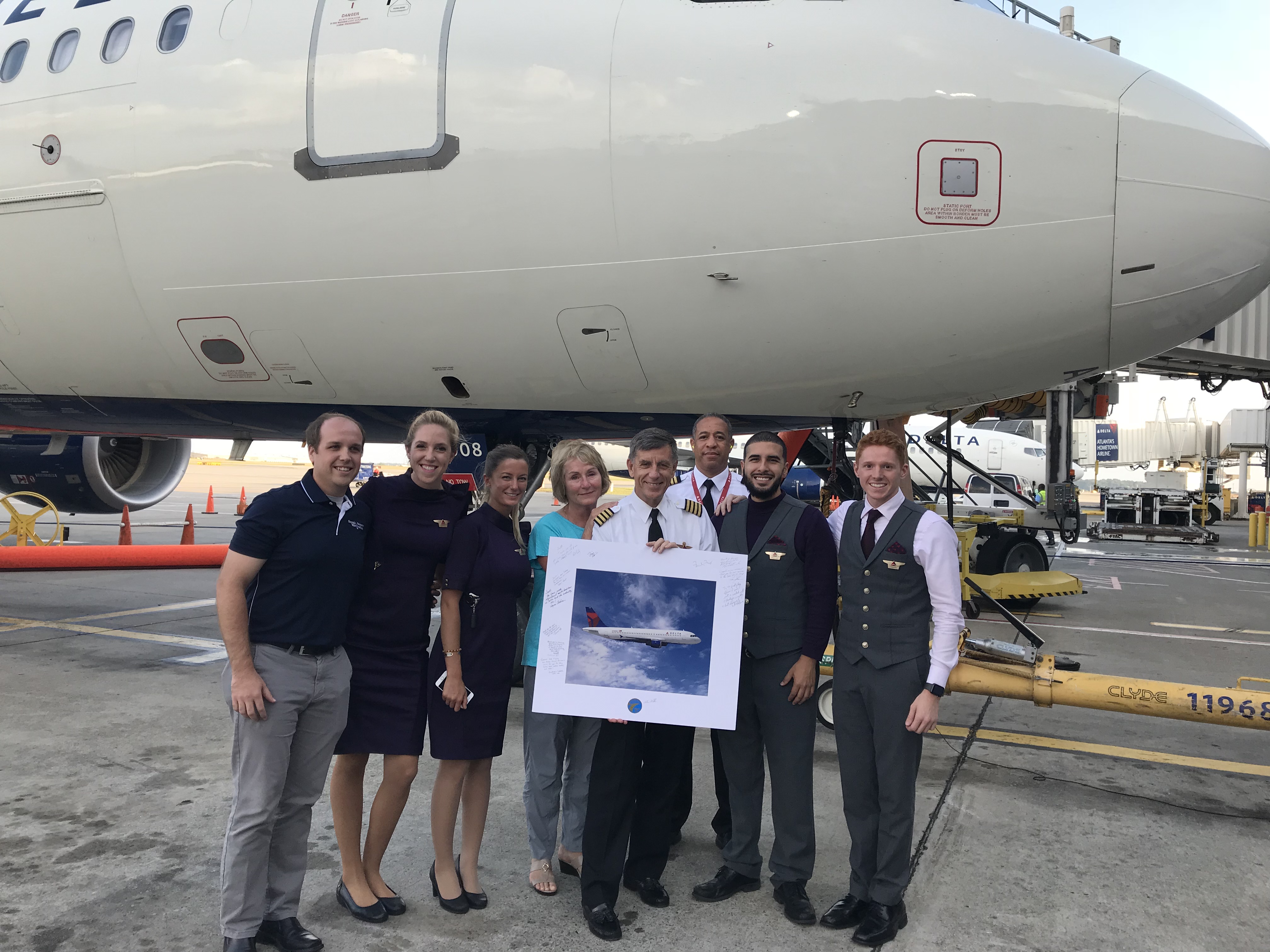Autobrakes Medium
By Capt. Scott Hammond (Delta, ret.)

Capt. Scott Hammond (Delta, ret.) poses after his final flight with his flight crew; wife, Cindy; and son, Josh.
Aug. 16, 2018, was clear and calm and felt normal right up until I approached the employee parking lot. Suddenly, I became acutely aware that everything I was doing was for the last time. I smiled through the car window and impulsively announced it was my last day. So much for normal. Boarding the crew bus, I made a mental note to shut up and focus on routine. Over the years I had read too many ASAP reports of final flights gone bad. I was determined not to be that person.
Atlanta, Ga., weather was spectacular, but coastal thunderstorms would keep our New Orleans, La., arrival interesting. At the gate, I met my first officer, Karamo Hayward, for the first time. I could sense he knew what he was doing, which helped me relax. I explained the whole fini-flight thing, with a caution not to let us (i.e., me) get distracted, and asked if he’d mind me stealing both legs, knowing what his answer would be.
My wife Cindy and son Josh were already on board, instant reminders that this was anything but a normal day. However, 50 years of flying counts for something. After I stepped on the flight deck and settled into the familiar routine of flows and checklists, final flight-itis receded. Departure and cruise were normal, except for extra attention to alternate forecast and fuel, just in case.
After two decades of flying the A320, my final flight was in a model I had very little time in—one of our new A321s. The significantly added mass of this jet would make getting down and stopped a somewhat less-than-familiar sensation. Anticipating that the runway might be wet from passing showers, we requested the long runway and I asked Karamo for autobrakes medium. This wouldn’t be the day I go skittering off the end. Josh was in back; I had taught him to fly and critiqued a hundred of his landings. He’d be critiquing mine.
Rolling out on final, the surface of Runway 11 appeared dry. A just-right nose-high touchdown early in the landing zone was sweet, and then…ka-baaang! The autobrakes grabbed, and the nosewheel slammed down. Holy smokes, it felt like a 5’g eyeballs-out deceleration before I could trip the autobrakes off with the toe brakes. We were down to taxi speed on the 10,000-foot-long runway with about 7,000 feet left.
At the gate, I opened the flight deck door to greet the passengers and provide the obligatory apology for the abrupt arrival. Josh remained behind until everyone deplaned. “Copilot landing, huh?” I thought for a nanosecond about throwing Karamo under the bus. “Nah, all mine. I own it.” This pleased Josh mightily. We both knew I’d be hearing about this landing again. And again.

ALPA president Capt. Tim Canoll, coincidentally commuting home to Atlanta, poses with Hammond before his final flight.
Less than an hour later, we were on our way back to Atlanta. Our flight attendants seemed genuinely enthusiastic to have stumbled into my very last leg. Halfway back the clouds dispersed. I took a moment to enjoy the view and file the memory away and then returned to the task at hand. My wife and son were still grading me, and the setting sun would be in my eyes.
Autobrakes low, touchdown average. During rollout, I could hear cheering and clapping in back. The landing wasn’t that good—but at least it was an improvement. Following some photos with my family and crew, the chief pilot drove me straight from the flight line to my car—valet service! I could get used to this—if it wasn’t my last day.
Retirement is great. I miss my many professional friends, the ALPA Air Safety Organization, and the sense of being a part of something bigger than me. I don’t miss the grind, early morning wake-ups, or middle-of-the-night safety texts. And I definitely don’t miss A321 medium autobrakes on long, dry runways.